Verdict
The 5020 is a rich-sounding, musical and powerful stereo speaker from Q Acoustics that entertains in spades.
Pros
- Lovely looking finish
- Musical performance with a sense of scale
- Relatively affordable
Cons
- Cabinet is on the big side
- Some may prefer an analytical or more revealing sound
Availability
- UKRRP: £599
- USARRP: $899
- EuropeRRP: €799
- CanadaTBC
- AustraliaTBC
-
Point-2-Point bracingInternal bracing to minimise low frequency vibrations -
C3 Continuous Curved ConeNew design mid/bass driver
Introduction
The Q Acoustics 5020 is a bookshelf hi-fi speaker from the British brand’s 5000 loudspeaker series.
It sits between Q Acoustics’ 3000i and Concept series, set up as middleground for those looking to create a stereo system for music or home cinema surround package.
It combines lessons learned from the company’s more reasonably priced series, while also incorporating technology from the Concept models to offer the best of both worlds – a fairly affordable stereo speaker with some high-end specs.
Design
- Great looking finish
- Big cabinet, heavy too
- Choice of optional or bespoke stand
You’ve probably heard this before, not least from this writer, but it’s no surprise that the 5020 bookshelf speaker looks very much like a Q Acoustic speaker.
There’s the trademark rounded cabinet and, once the magnetically attached baffle is off, the tweeter and mid-bass driver combo with the concentric circles around each drive unit, and glossy finish on its front surface – it’s a familiar sight.
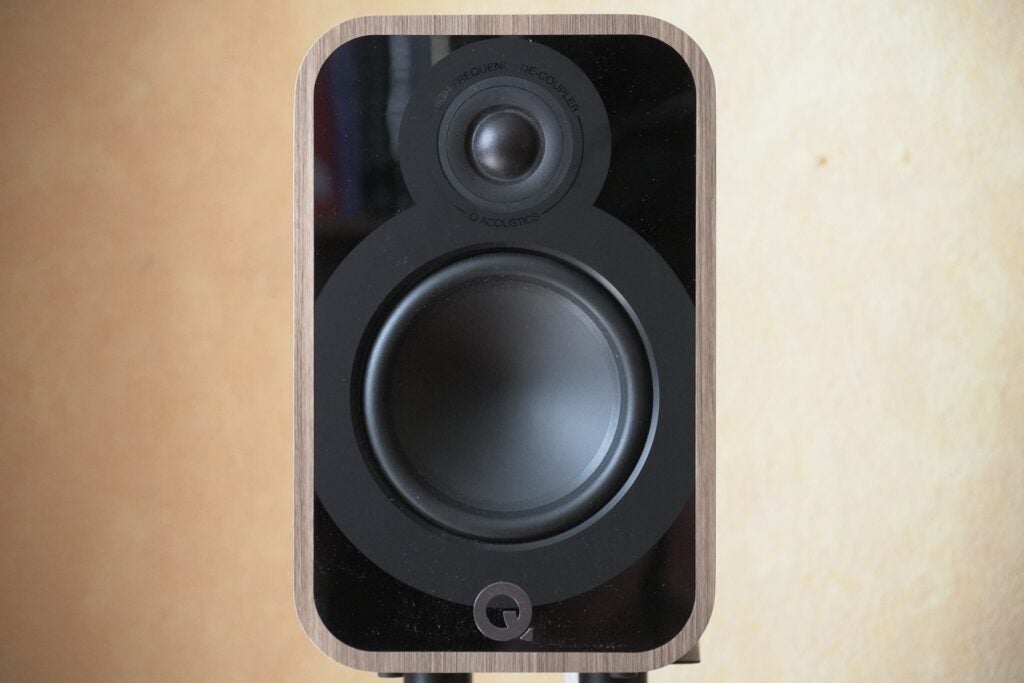
At first glance the 5020’s cabinet looks deep, though not as deep as the Concept 30 – 293mm vs 319mm. Considering it’s described as a bookshelf speaker, the 5020 is rather big, and at 7kg per speaker heavy too. The 5010 model is more compact than this one is but also features a smaller bass driver.
They could be plonked on a stand of your own choice, and Q Acoustics sells its own bespoke Q 3000FSi stand that the 5020 could be screwed into (it also sells wall brackets). The speaker only supports single-wired operation with no bi-wiring possible. Bungs are provided to stuff the rear port to help manage the bass performance and Q Acoustics recommends placing them with at least 0.2m of space behind them.
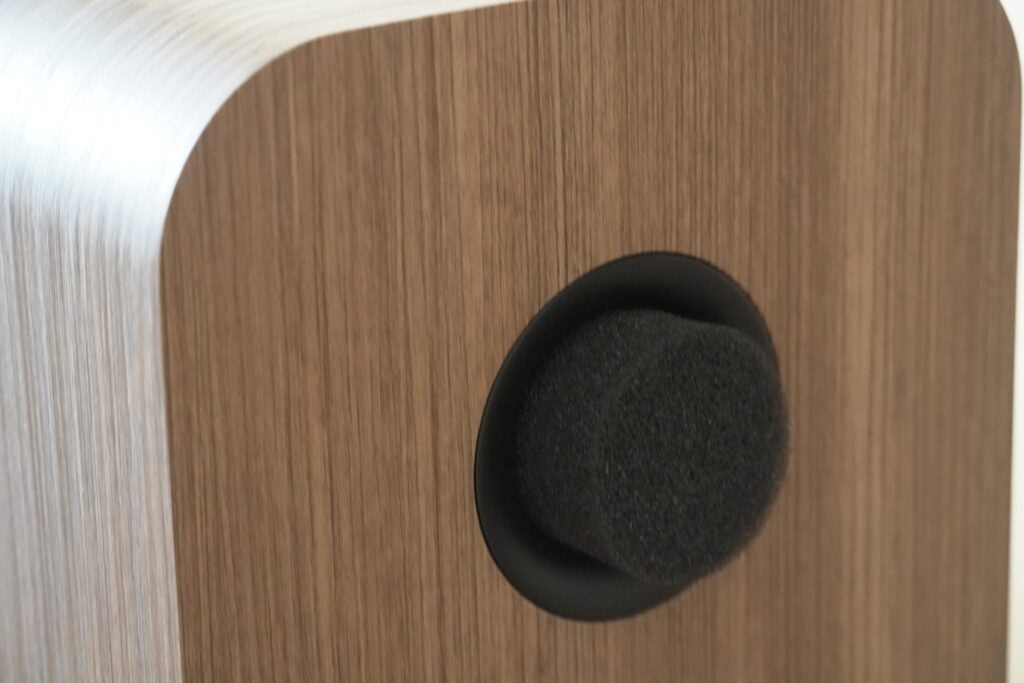
The main aesthetic difference between the 5020 and Concept 30 is the type of finish on the speakers. The 5020 opts for the more natural look with a choice of four finishes in Satin Black, Satin White, Santos Rosewood and Holme Oak (which is this sample supplied for review).
Features
- New mid-bass driver
- Hermetically sealed high-frequency driver
- Wide frequency range
Like the Concept 30 borrowed technology from the Concept 300, the 5020 borrow from the Concept 30. Although there is new technology built for the 5000 series from the ground up in the form of the Continuous Curved Cone design.
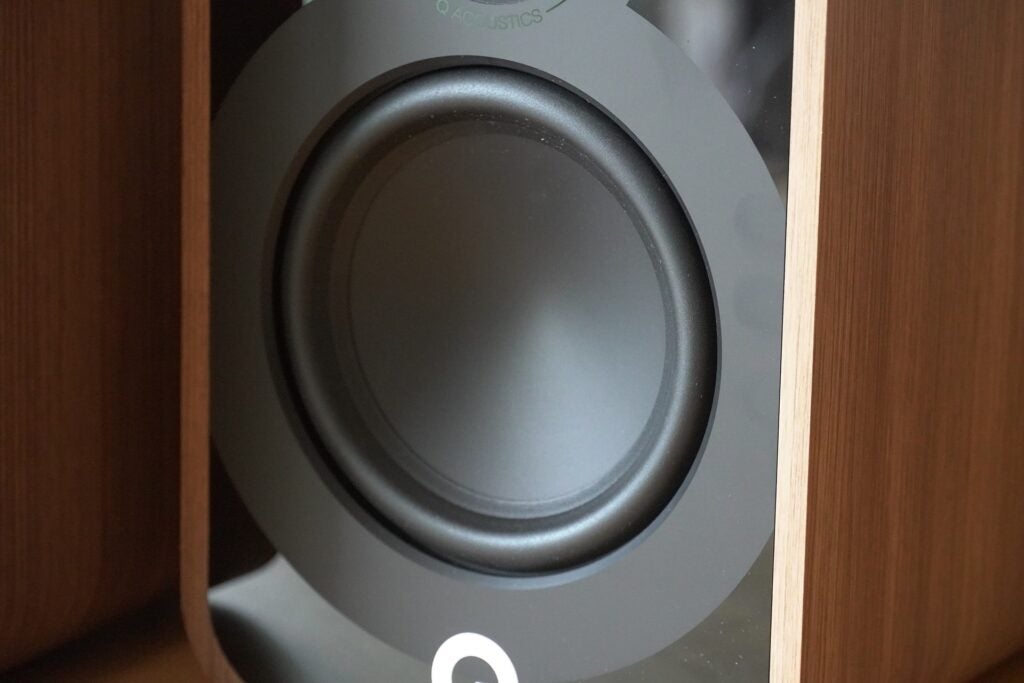
Continuous Curved Cone design, pronounced C-cubed, is the new mid-bass driver made from what Q Acoustic’s described as a “single, smooth, continuous curved profile”. The aim is to ensure smoother integration with the high-frequency tweeter and superior bass dynamics.
The high-frequency tweeter has also been hermetically sealed and mechanically isolated (essentially, it’s floating) from the baffle to protect against the internal cabinet pressure or resonances produced from the mid-bass driver. P2P (Point-2-Point) is internal bracing that stiffens the cabinet to reduce lower frequency vibrations and improve the stereo image the Q Acoustics 5020 creates.
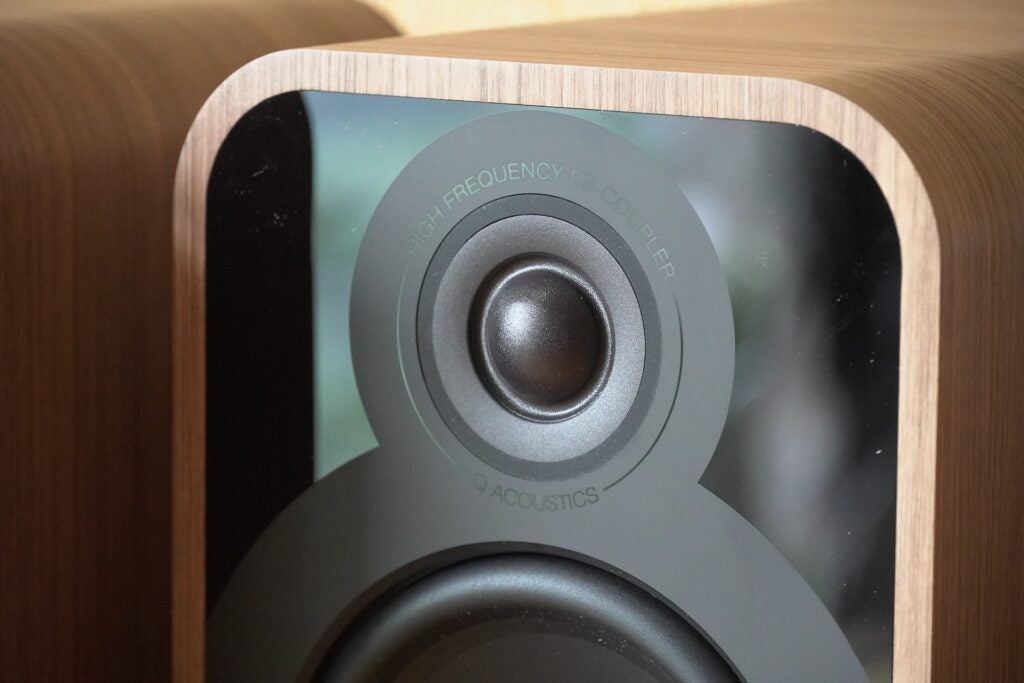
Other need-to-know details include a frequency response of 53Hz to 30kHz, sensitivity of 87.9dB and a minimal impedance of 3.3ohms (a nominal impedance of 6). Q Acoustics recommends a power supply of 25 – 100W from a partnered amplifier.
Performance
- Taut but also agile bass
- Rich, musical tone
- Bigger in terms of scale than 3000i series
You know what else is familiar about the Q Acoustics 5020? How it sounds. This isn’t a million miles away from the Q Acoustics 3020i stereo speaker. There’s a similar richness that has pervaded through many a Q Acoustics’ speaker, the weighty and powerful low frequency performance, along with the spacious stereo image.
But what’s made clear from the 3000i series of speakers is the sense of scale, energy, and power that the 5020 can produce. The warmth is notable, and I’d say that the 5020 lacks the Concept 30’s levels of precision and sharpness (at least from what I can recall) – this isn’t the most analytical or revealing stereo speaker, but once the right volume has been found it is tremendously fun listen.
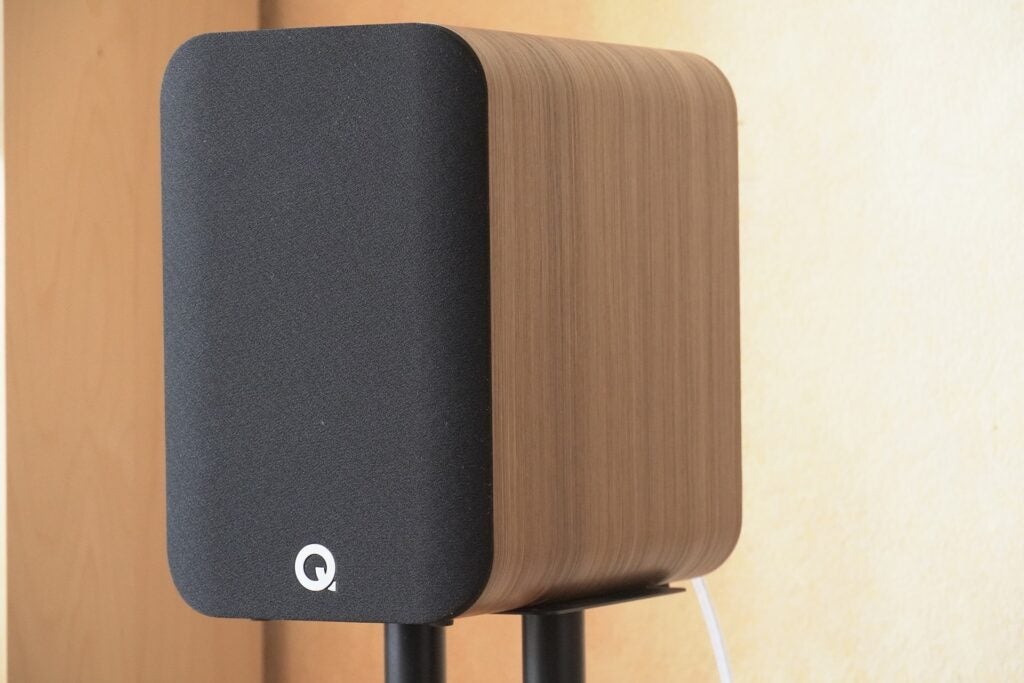
Partnered with the Cambridge Audio duo of the CXN v2 and CXA61 (and connected via QED Reference XT25 cables), the 5020 exudes a fluid, rich and musical sense of flow with music. With Jorja Smith’s Addicted (Qobuz) the 5020 captures the size and weight of the low frequencies that underpin the song, but that bass doesn’t become the sole focus of the song, it’s taut in description and doesn’t impinge on the midrange.
There’s good balance to be heard here, and the soundstage described is capital B big. I’m not sure I believe Q Acoustics’ line about the speaker putting the listener in the midst of the music “without putting itself at the heart of your space”. With the right track I find both statements are true.
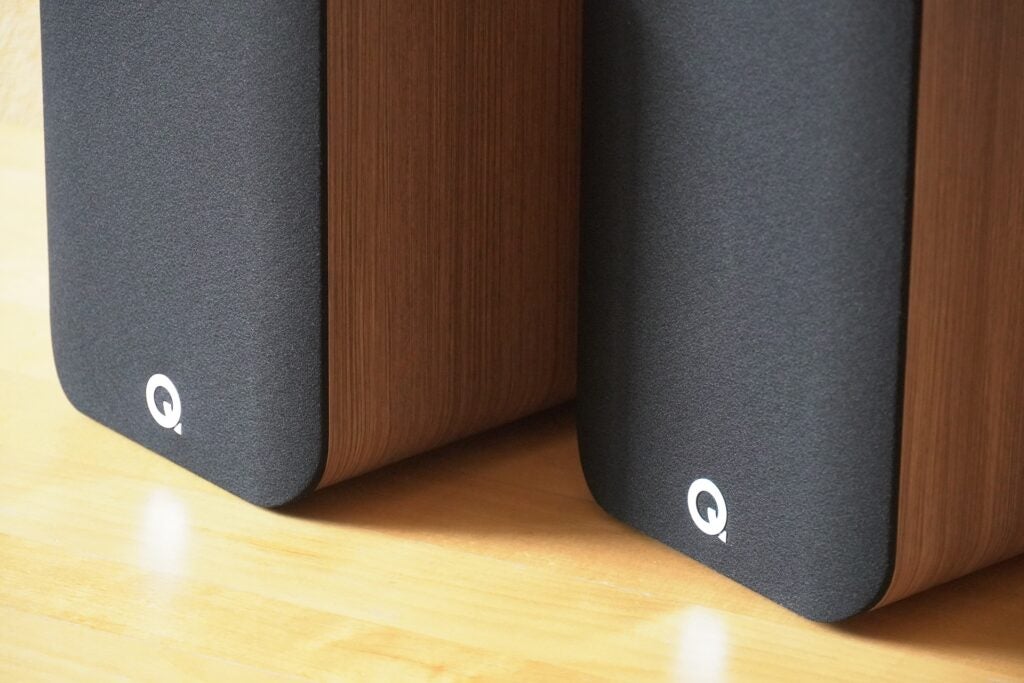
And the high-frequency performance is bright, but it doesn’t necessarily sparkle with a sharpness of brilliance in Water Traveller from Joe Hisashi. But I find myself not minding that slightly relaxed approach to high frequencies that I hear. There’s still a decent decay to trailing edges of treble notes and brightness still registers – it’s not dulled in any sense.
There’s a richness that pervades across the entirety of the frequency range and I’ve enjoyed how the treble is integrated within the overall performance – the Q Acoustic 5020’s sound feels like a cohesive whole. I only meant to listen to a few tracks from Isfar Sarabski’s Planet (Qobuz) but ended up listening to most of the album.
Despite the richness, the 5020 is no slouch in terms of rhythmic ability – it’s dynamic, the bass is weighty and agile, transitions from fast to slow and vice versa are handled well, and the richness of the midrange/low frequencies brings out a lovely sense of detail and weight as a double bass is being plucked in Limping Stranger.
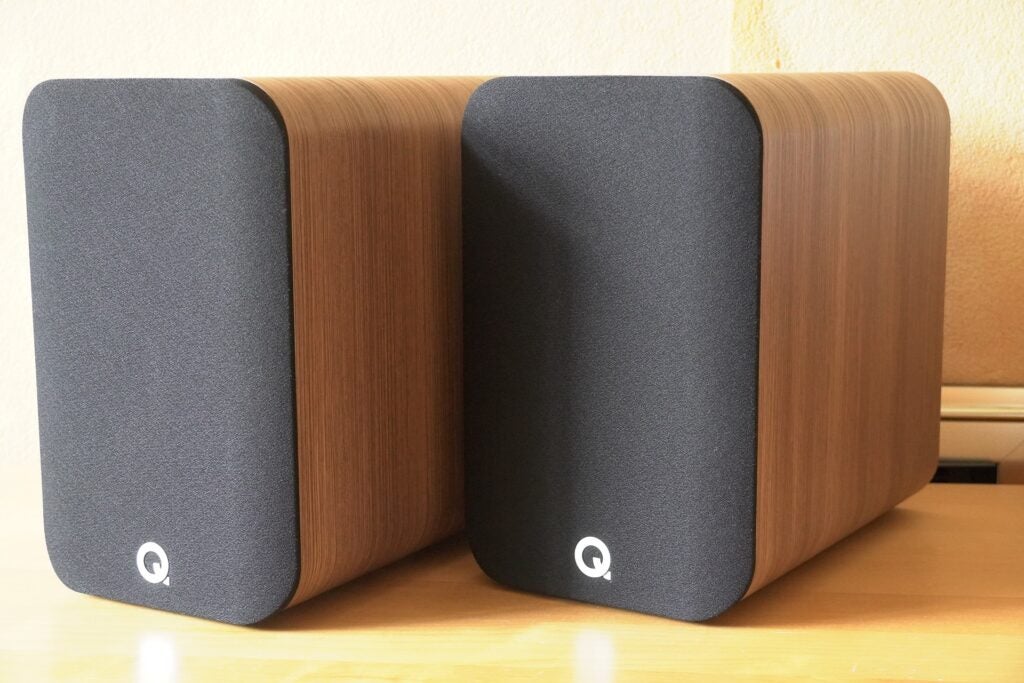
Latest deals
Should you buy it?
If you like rich musicality: The tonality of the 5020 may change with whatever set-up you have, but with a Cambridge Audio set-up it produced a lively, energetic, and fun performance.
If you need a smaller speaker: The 5020 are big, bigger than the 3000i series so if you have a smaller room perhaps opt for that series instead.
Final Thoughts
In my estimation, the 5020 carries on from the great work established by the more affordable 3000i series, but brings more scale, energy, and weight to its performance. It doesn’t have the precision of the Concept 30 I would say, it’s not as revealing but the baton is passed on in terms of being fantastically entertaining.
Its size may prove an issue in terms of finding space for it, but this is another zinger from Q Acoustics: a great-looking and musically entertaining speaker from the company.
How we test
We test every hi-fi speaker we review thoroughly over an extended period of time. We use industry-standard tests to compare features properly. We’ll always tell you what we find. We never, ever, accept money to review a product.
Find out more about how we test in our ethics policy.
Tested with real world use
FAQs
The 5020 stereo speaker only supports single-wired connectivity, so there’s no support for bi-wire speaker terminals.
Sustainability
Trusted Reviews’ holds the fact that global warming is not a myth as a core value and will continuously endeavour to help protect our planet from harm in its business practices.
As part of this mission, whenever we review a product we send the company a series of questions to help us gauge and make transparent the impact the device has on the environment.
We currently haven’t received answers to the questions on this product, but will update this page the moment we do. You can see a detailed breakdown of the questions we ask and why in our sustainability page.
Jargon buster
Tweeter
A tweeter is a type of loudspeaker driver that’s designed to reproduce high frequency (treble) sounds.
Midrange
Midrange refers to the part of the frequency range that sits between the bass and treble. The midrange is the area that handles vocals and most of the instruments heard in a track. It can also be in reference to midrange loudspeaker drivers that replicate this area of the frequency range.
Verdict
The 5020 is a rich-sounding, musical and powerful stereo speaker from Q Acoustics that entertains in spades.
Pros
- Lovely looking finish
- Musical performance with a sense of scale
- Relatively affordable
Cons
- Cabinet is on the big side
- Some may prefer an analytical or more revealing sound
Availability
- UKRRP: £599
- USARRP: $899
- EuropeRRP: €799
- CanadaTBC
- AustraliaTBC
-
Point-2-Point bracingInternal bracing to minimise low frequency vibrations -
C3 Continuous Curved ConeNew design mid/bass driver
Introduction
The Q Acoustics 5020 is a bookshelf hi-fi speaker from the British brand’s 5000 loudspeaker series.
It sits between Q Acoustics’ 3000i and Concept series, set up as middleground for those looking to create a stereo system for music or home cinema surround package.
It combines lessons learned from the company’s more reasonably priced series, while also incorporating technology from the Concept models to offer the best of both worlds – a fairly affordable stereo speaker with some high-end specs.
Design
- Great looking finish
- Big cabinet, heavy too
- Choice of optional or bespoke stand
You’ve probably heard this before, not least from this writer, but it’s no surprise that the 5020 bookshelf speaker looks very much like a Q Acoustic speaker.
There’s the trademark rounded cabinet and, once the magnetically attached baffle is off, the tweeter and mid-bass driver combo with the concentric circles around each drive unit, and glossy finish on its front surface – it’s a familiar sight.

At first glance the 5020’s cabinet looks deep, though not as deep as the Concept 30 – 293mm vs 319mm. Considering it’s described as a bookshelf speaker, the 5020 is rather big, and at 7kg per speaker heavy too. The 5010 model is more compact than this one is but also features a smaller bass driver.
They could be plonked on a stand of your own choice, and Q Acoustics sells its own bespoke Q 3000FSi stand that the 5020 could be screwed into (it also sells wall brackets). The speaker only supports single-wired operation with no bi-wiring possible. Bungs are provided to stuff the rear port to help manage the bass performance and Q Acoustics recommends placing them with at least 0.2m of space behind them.

The main aesthetic difference between the 5020 and Concept 30 is the type of finish on the speakers. The 5020 opts for the more natural look with a choice of four finishes in Satin Black, Satin White, Santos Rosewood and Holme Oak (which is this sample supplied for review).
Features
- New mid-bass driver
- Hermetically sealed high-frequency driver
- Wide frequency range
Like the Concept 30 borrowed technology from the Concept 300, the 5020 borrow from the Concept 30. Although there is new technology built for the 5000 series from the ground up in the form of the Continuous Curved Cone design.

Continuous Curved Cone design, pronounced C-cubed, is the new mid-bass driver made from what Q Acoustic’s described as a “single, smooth, continuous curved profile”. The aim is to ensure smoother integration with the high-frequency tweeter and superior bass dynamics.
The high-frequency tweeter has also been hermetically sealed and mechanically isolated (essentially, it’s floating) from the baffle to protect against the internal cabinet pressure or resonances produced from the mid-bass driver. P2P (Point-2-Point) is internal bracing that stiffens the cabinet to reduce lower frequency vibrations and improve the stereo image the Q Acoustics 5020 creates.

Other need-to-know details include a frequency response of 53Hz to 30kHz, sensitivity of 87.9dB and a minimal impedance of 3.3ohms (a nominal impedance of 6). Q Acoustics recommends a power supply of 25 – 100W from a partnered amplifier.
Performance
- Taut but also agile bass
- Rich, musical tone
- Bigger in terms of scale than 3000i series
You know what else is familiar about the Q Acoustics 5020? How it sounds. This isn’t a million miles away from the Q Acoustics 3020i stereo speaker. There’s a similar richness that has pervaded through many a Q Acoustics’ speaker, the weighty and powerful low frequency performance, along with the spacious stereo image.
But what’s made clear from the 3000i series of speakers is the sense of scale, energy, and power that the 5020 can produce. The warmth is notable, and I’d say that the 5020 lacks the Concept 30’s levels of precision and sharpness (at least from what I can recall) – this isn’t the most analytical or revealing stereo speaker, but once the right volume has been found it is tremendously fun listen.

Partnered with the Cambridge Audio duo of the CXN v2 and CXA61 (and connected via QED Reference XT25 cables), the 5020 exudes a fluid, rich and musical sense of flow with music. With Jorja Smith’s Addicted (Qobuz) the 5020 captures the size and weight of the low frequencies that underpin the song, but that bass doesn’t become the sole focus of the song, it’s taut in description and doesn’t impinge on the midrange.
There’s good balance to be heard here, and the soundstage described is capital B big. I’m not sure I believe Q Acoustics’ line about the speaker putting the listener in the midst of the music “without putting itself at the heart of your space”. With the right track I find both statements are true.

And the high-frequency performance is bright, but it doesn’t necessarily sparkle with a sharpness of brilliance in Water Traveller from Joe Hisashi. But I find myself not minding that slightly relaxed approach to high frequencies that I hear. There’s still a decent decay to trailing edges of treble notes and brightness still registers – it’s not dulled in any sense.
There’s a richness that pervades across the entirety of the frequency range and I’ve enjoyed how the treble is integrated within the overall performance – the Q Acoustic 5020’s sound feels like a cohesive whole. I only meant to listen to a few tracks from Isfar Sarabski’s Planet (Qobuz) but ended up listening to most of the album.
Despite the richness, the 5020 is no slouch in terms of rhythmic ability – it’s dynamic, the bass is weighty and agile, transitions from fast to slow and vice versa are handled well, and the richness of the midrange/low frequencies brings out a lovely sense of detail and weight as a double bass is being plucked in Limping Stranger.

Latest deals
Should you buy it?
If you like rich musicality: The tonality of the 5020 may change with whatever set-up you have, but with a Cambridge Audio set-up it produced a lively, energetic, and fun performance.
If you need a smaller speaker: The 5020 are big, bigger than the 3000i series so if you have a smaller room perhaps opt for that series instead.
Final Thoughts
In my estimation, the 5020 carries on from the great work established by the more affordable 3000i series, but brings more scale, energy, and weight to its performance. It doesn’t have the precision of the Concept 30 I would say, it’s not as revealing but the baton is passed on in terms of being fantastically entertaining.
Its size may prove an issue in terms of finding space for it, but this is another zinger from Q Acoustics: a great-looking and musically entertaining speaker from the company.
How we test
We test every hi-fi speaker we review thoroughly over an extended period of time. We use industry-standard tests to compare features properly. We’ll always tell you what we find. We never, ever, accept money to review a product.
Find out more about how we test in our ethics policy.
Tested with real world use
FAQs
The 5020 stereo speaker only supports single-wired connectivity, so there’s no support for bi-wire speaker terminals.
Sustainability
Trusted Reviews’ holds the fact that global warming is not a myth as a core value and will continuously endeavour to help protect our planet from harm in its business practices.
As part of this mission, whenever we review a product we send the company a series of questions to help us gauge and make transparent the impact the device has on the environment.
We currently haven’t received answers to the questions on this product, but will update this page the moment we do. You can see a detailed breakdown of the questions we ask and why in our sustainability page.
Jargon buster
Tweeter
A tweeter is a type of loudspeaker driver that’s designed to reproduce high frequency (treble) sounds.
Midrange
Midrange refers to the part of the frequency range that sits between the bass and treble. The midrange is the area that handles vocals and most of the instruments heard in a track. It can also be in reference to midrange loudspeaker drivers that replicate this area of the frequency range.

























